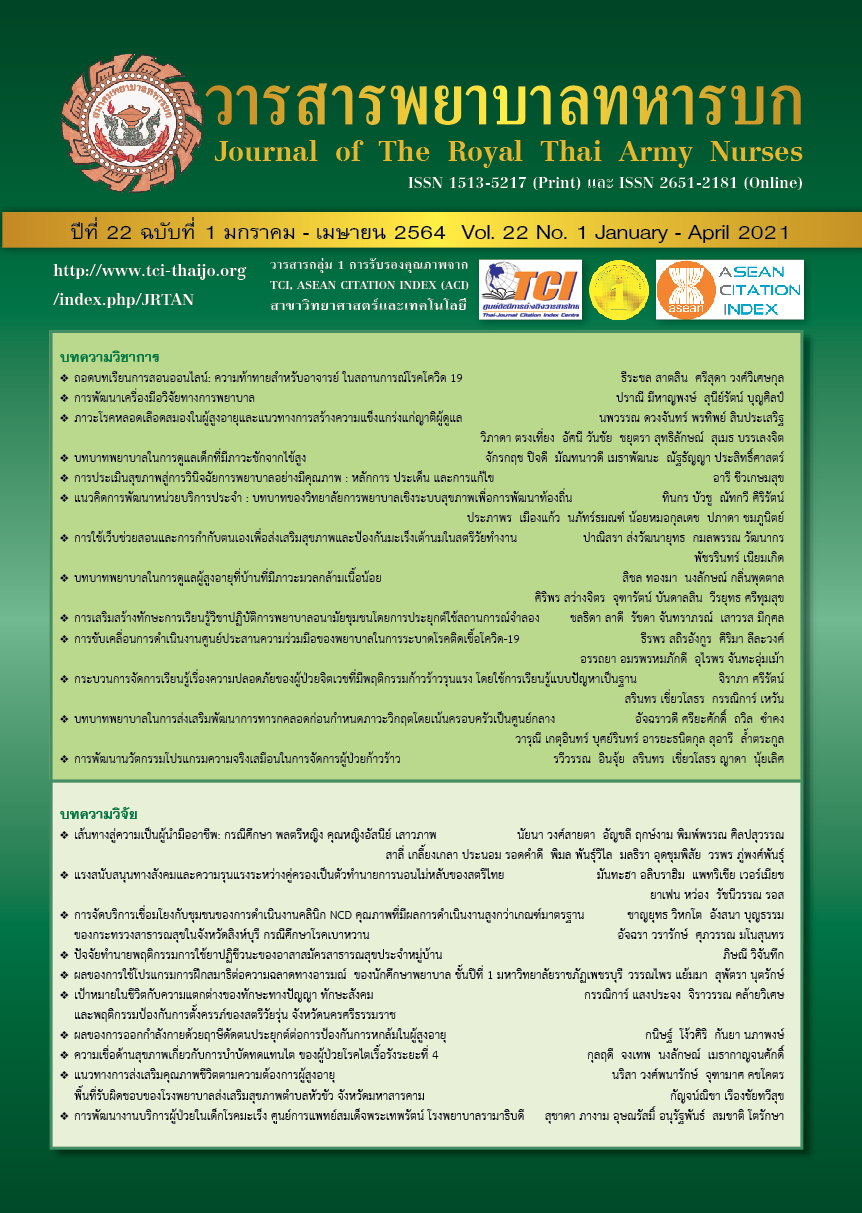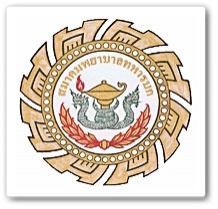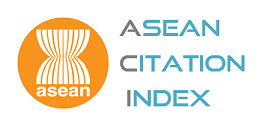บทบาทพยาบาลในการดูแลผู้สูงอายุที่บ้านที่มีภาวะมวลกล้ามเนื้อน้อย
คำสำคัญ:
ภาวะมวลกล้ามเนื้อน้อย, ผู้สูงอายุ, บทบาทพยาบาลบทคัดย่อ
ภาวะมวลกล้ามเนื้อน้อยเป็นส่วนหนึ่งของกลุ่มอาการที่เกิดขึ้นบ่อยในผู้สูงอายุ ในประเทศไทยพบความชุกภาวะมวลกล้าม เนื้อน้อยประมาณ 1 ใน 3 ของประชากรทั่วไป โดยพบร้อยละ 32.5 ในเพศชาย และร้อยละ 34.5 ในเพศหญิง โดยภาวะมวลกล้าม เนื้อพบมากขึ้นเมื่ออายุเพิ่มมากขึ้น การเกิดภาวะมวลกล้ามเนื้อน้อยเป็นสาเหตุของการเจ็บป่วยเพิ่มขึ้น เสี่ยงต่อการเกิดภาวะเปราะ บาง ความสามารถในการทำกิจวัตรประจำวันลดลง เพิ่มความเสี่ยงในการหกล้มและการเกิดโรคหัวใจและหลอดเลือด ความสามารถ ในการทำงานและคุณภาพชีวิตลดลง ค่าใช้จ่ายในการรักษาพยาบาลและเพิ่มอัตราการเสียชีวิตเพิ่มขึ้น ดังนั้นพยาบาลชุมชน และพยาบาลดูแลผู้ป่วยที่บ้านถือเป็นบุคคลที่ใกล้ชิดกับผู้สูงอายุที่บ้านมากที่สุด พยาบาลมีบทบาทตั้งแต่การประเมินหรือคัดกรอง กลุ่มเสี่ยงในการเกิดภาวะมวลกล้ามเนื้อน้อย การประเมินภาวะแทรกซ้อนหลังเกิดภาวะมวลกล้ามเนื้อน้อยโดยเฉพาะการพลัดตก หกล้ม การส่งเสริมกิจกรรมทางกายและการออกกำลังกายทั้งการออกกำลังกายแบบมีแรงต้านและแบบแอโรบิก การส่งเสริมภาวะ โภชนาการ และการลด/งดสูบบุหรี่และดื่มแอลกอฮอล์มีความสำคัญเพื่อส่งเสริมการทำหน้าที่ของร่างกายในผู้สูงอายุ เพื่อให้ผู้สูงอายุ สามารถพึ่งพาตนเองได้ ไม่เกิดภาระต่อครอบครัวและผู้ดูแล รวมทั้งเป็นตัวบ่งชี้คุณภาพในการดูแลผู้สูงอายุของพยาบาลในชุมชน และพยาบาลดูแลผู้ป่วยที่บ้าน
Downloads
เอกสารอ้างอิง
Chuharas S, Darikarniert L, Kaewket W, Thananchai C. Situation of the Thai elderly 2019. Bangkok: Foundation of Thai Gerontology Research and Development Institute; 2020. National Committee on the Elderly and The Older Fund. (in Thai)
Espinoza SE, Fried LP. CME article: Risk factors for frailty in the older adult. Clinical Geriatrics. 20027; 15(6): 37-44.
Promklang D, Piaseu N, Maruo SJ, Tantiprasoplap S. Factors associated with sarcopenia amongst older adults in congested communities in Bangkok. Thai Journal of Nursing Council. 2018; 33(1): 49-60. (in Thai)
Haehling SV, Morley JE, Anker SD. An Overview of sarcopenia: Facts and numbers on prevalence and clinical impact. Cachexia Sarcopenia Muscle. 2010; 1(2): 129-33.
Mitchell WK, Williams J, Atherton P, Larvin M, Lund J, Narici M. Sarcopenia, dynapenia, and the impact of advancing age on human skeletal muscle size and strength; a quantitative review. Frontiers in Physiology. 2012;3:260.1-8.
Janssen I. The epidemiology of sarcopenia. Clinics in Geriatric Medicine. 2011; 27: 355-63.
Pongchaiyakul C, Limpawattana P, Kotruchin P, Rajatanavin R. Prevalence of sarcopenia and associated factors among Thai population. Journal of Bone and Mineral Metabolism. 2013; 31: 346-350.
Chomwattanachai S, Niamhom S, Duangdee S, Permbotasi T. The effectiveness of resistance exercise in elderly with sarcopenia: A systematic review. Journal of the Department of Medical Services. 2019; 44(1): 47-51. (in Thai)
Cruz-Jentoft AJ, Baeyens JP, Bauer JM, Boirie Y, Cederholm T, Landi F, et al. Sarcopenia: European consensus on definition and diagnosis: Report of the European Working Group on Sarcopenia in Older People. Age and ageing. 2010; 39(4): 412-23.
Fielding RA, Vellas B, Evans WJ, Bhasin S, Morley JE, Newman AB, et al. Sarcopenia: an undiagnosed condition in older adults. Current consensus definition: prevalence, etiology, and consequences. International working group on sarcopenia. Journal of the American Medical Directors Association. 2011; 12(4): 249-56.
Podsiadlo D, Richardson S. The timed “Up & Go”: a test of basic functional mobility for frail elderly persons. Journal of the American Geriatrics Society. 1991; 39(2): 142-8.
Borst SE. Interventions for sarcopenia and muscle weakness in older people. Age Ageing. 2004; 33: 548-555.
Rizzoli R, Reginster JY, Arnal JF, Bautmans I, Beaudart C, Bischoff-Ferrari H, et al. Quality of life in sarcopenia and frailty. Calcified Tissue International. 2013; 93(1).
Van Ancum JM, Meskers CGM, Reijnierse EM, Yeung SSY, Jonkman NH, Trappenburg MC, et al. Lack of knowledge contrasts the willingness to counteract sarcopenia among community-dwelling adults. Journal of Aging and Health. 2020; 32(8): 787-794.
Fong TG, Tulebaev SR, Inouye SK. Delirium in elderly adults: Diagnosis, prevention, and treatment. Nature Reviews Neurology. 2009; 5(4): 210-220.
Saczynski JS, Marcantonio ER, Quach L, Fong TG, Gross A, Inouye SK, et al. Cognitive trajectories after postoperative delirium. The New England Journal of Medicine. 2012; 367(1): 30-39.
Limpawattana P. Frailty and sarcopenia. In Institute of Geriatric Medicine, Thailand. Geriatric syndrome. Bangkok: Is August Company Limited, 2015; 39-51. (in Thai)
Yakabe M, Ogawa S, Akishita M. Clinical manifestations and pathophysiology of sarcopenia. Biomedical Sciences. 2015; 1(2): 10-7.
LTC William J. Brown and Mary S. McCarthy. Sarcopenia: What Every NP Needs to Know. The Journal for Nurse Practitioners. 2015); 11(8): 753-760.
Chen LK, Woo J, Assantachai P, Auyeung TW, Chou MY, Iijima K, et al. Asian working group for sarcopenia: 2019 Consensus update on sarcopenia diagnosis and treatment. Journal of the American Medical Directors Association. 2020; 21(3): 300-07.
Tremblay MS, Aubert S, Barnes JD, Saunders TJ, Carson V, Latimer-Cheung AE, et al. Sedentary Behavior Research Network (SBRN) - Terminology consensus project process and outcome. International Journal of Behavioral Nutrition and Physical Activity. 2017; 14(1): 75.
Chen LK, Liu LK, Woo J, Assantachai P, Auyeung TW, Bahyah KS, et al. Sarcopenia in Asia: consensus report of the Asian Working Group for Sarcopenia. Journal of the American Medical Directors Association. 2014; 15(2): 95-101.
Rodseeda P. fall prevention among the elderly living in a community: the nursing role in home health care. Thai red cross nursing journal. 2018; 11(2): 15-25. (in Thai)
Thiamwong L, Thamarpirat J, Maneesriwongul W, Jitapunkul S. Thai Falls Risk Assessment Test (Thai-FRAT) Developed for CommunityDwelling Thai Elderly. Journal of the Medical Association of Thailand. 2008; 91(12): 1823-32. (in Thai)
Freiberger E, Sieber C, Pfeifer K. Physical activity, exercise, and sarcopenia-future challenges. Wien Med Wochenschr 2011; 161: 416–25.
Panyoyai P. Aerobic exercise among the elderly. Journal of nursing science and health. 2012; 35(2): 140-8. (in Thai)
Panasupon L. Effect of progressive resistance and aerobic exercise training on physical performance in elderly women with sarcopenia. [Master Thesis]. Bangkok: Chulalongkorn University; 2016. (in Thai)
Rom O, Kaisari S, Aizenbud D, Reznick AZ. Lifestyle and sarcopenia-etiology, prevention, and treatment. Rambam Maimonides Medical Journal. 2012; 3(4): 24.
Limpawattana P, Putraveephong S. Frailty and sarcopenia. KKU Journal of Medicine.2015; 1(4): 10-6. (in Thai)
Wongpanarak N, Chaleoykitti S. Quality of Life: A study of elderly in Thailand. Journal of The Royal Thai Army Nurses.2014;15(3):64-70 (in Thai)
ดาวน์โหลด
เผยแพร่แล้ว
รูปแบบการอ้างอิง
ฉบับ
ประเภทบทความ
สัญญาอนุญาต
บทความหรือข้อคิดเห็นใดใดที่ปรากฏในวารสารพยาบาลทหารบกเป็นวรรณกรรมของผู้เขียน ซึ่งบรรณาธิการหรือสมาคมพยาบาลทหารบก ไม่จำเป็นต้องเห็นด้วย
บทความที่ได้รับการตีพิมพ์เป็นลิขสิทธิ์ของวารสารพยาบาลทหารบก
The ideas and opinions expressed in the Journal of The Royal Thai Army Nurses are those of the authors and not necessarily those
of the editor or Royal Thai Army Nurses Association.







